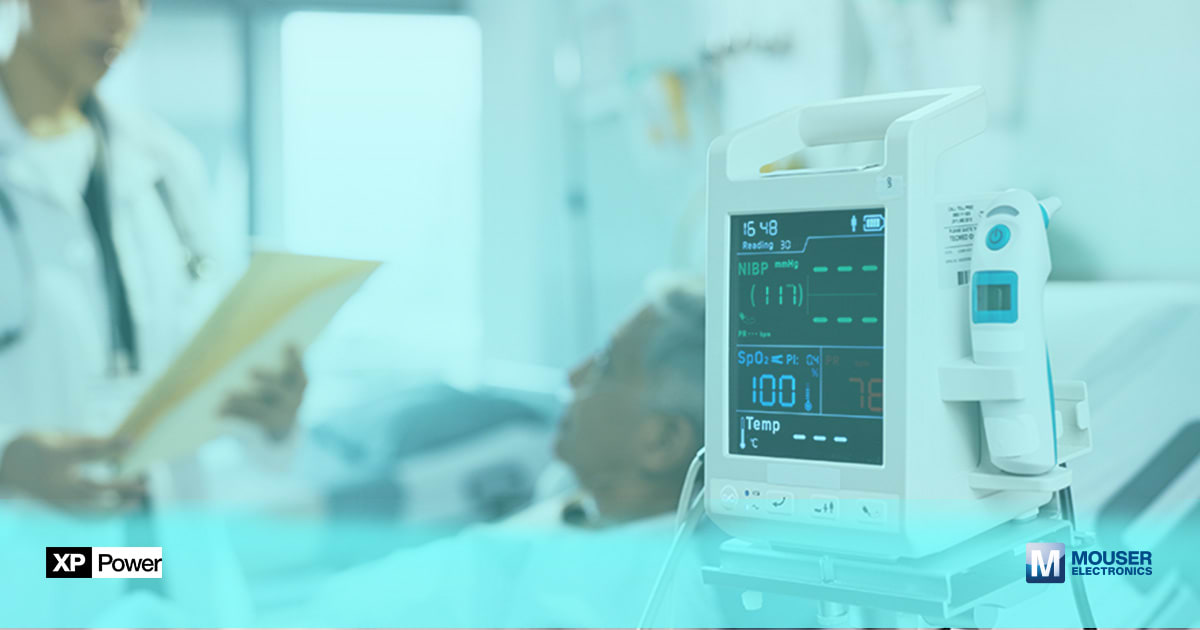Quiet, Please!
Designing for Noise Reduction in Hospital Settings

Image Source: Mouser Electronics
By Marcel Consée, Mouser Electronics
Noisy hospital and clinical environments are undesirable for both patients and healthcare workers. But what can be done to quieten critical devices in this setting? This blog looks at the features needed in power solutions for hospital environments, outlining their safety and compliance considerations that should be at the forefront of the minds of design engineers.
Excessive noise in healthcare settings can stress patients and delay recovery. On top of being distracting and irritating, it can also affect the communication and effectiveness of nursing staff and clinicians.
The Need for Silent, Sealed Medical Devices
Many medical devices—such as patient monitors, imaging equipment, infusion pumps, and surgical systems—depend on continuous, stable power in hospitals, clinics, and laboratories. However, traditional power supplies often rely on active cooling systems, which produce mechanical noise that can disturb patients and disrupt communication between healthcare staff. Silent power supplies address this challenge through fanless designs, advanced thermal management, and low-noise electronic components.
Fanless power supplies use passive cooling mechanisms such as heat sinks and conduction cooling. These systems dissipate heat efficiently without relying on moving parts, thereby eliminating fan noise and reducing the risk of mechanical failure. This results in greater reliability and lower maintenance needs, both critical in healthcare environments where equipment uptime is paramount.
Another advantage of silent power supplies is their suitability for compact or enclosed medical equipment. By removing the need for airflow ventilation, these designs support sealed, easy-to-clean enclosures that help maintain hygiene and reduce infection risk, which are key concerns in modern healthcare.
In such a sealed environment, it is advantageous for waste heat to be conducted away to the external enclosure. This enables compact design of the end equipment and minimises the internal temperature rise, optimising the reliability and service lifetime of the device.
Designers of medical devices and healthcare equipment need power solutions that can be successfully implemented and verified by regulatory institutions. By using an easy-to-integrate, off-the-shelf product incorporating the specifications and features demanded by medical device applications, designers can minimise development costs and approval time.
An ideal AC-DC power solution for the latest medical devices is a low-profile, small-footprint, high-efficiency, high-density, conduction- or convection-cooled power supply with EMC and safety certification for global healthcare applications.
A Compact, Efficient Power Solution
The CCP550 series of AC-DC power supplies by XP Power, with its compact size, low profile, high efficiency design, combined with convection and conduction cooling options, makes the range a great fit for sealed and fanless medical devices, including BF rated applications, with power requirements from 200W to 400W. The CCP550 has a compact 3" × 5" footprint, low 1.5" profile, high efficiency, and high-power density. These features allow it to be embedded into the device, with minimal waste heat conducted to the enclosure through the power supply baseplate.
The CCP550 readily supports up to 300W at input voltages as low as 85VAC using conduction cooling and up to 235W at the same input voltage using convection cooling. The optional 5V standby supply is rated up to 1A when convection or conduction cooled.

Figure 1: The XP Power CCP550 Series (Source: Mouser Electronics)
Ensuring Safety and Compliance
Medical power supplies must meet stringent standards such as IEC 60601 for safety and electromagnetic compatibility. Silent power solutions are increasingly designed to meet these requirements while exceeding noise performance and energy efficiency expectations.
The CCP550 power supply’s product data sheet provides service life curves based on the average operating temperature of key electrolytic capacitors. This specific product data can be used to evaluate the product service life when installed in the individual application based on the equipment's component temperatures, daily usage, and thermal mission profile in its unique cooling environment. It also identifies the maximum key component temperatures for safety compliance, providing confidence that the cooling in the application is adequate for system safety approvals.
Conclusion
As healthcare shifts toward more patient-centric, technology-integrated care environments, the role of silent power supplies is becoming more prominent. These solutions support a quieter, calmer setting conducive to healing and align with the growing demand for reliable, efficient, and hygienic medical devices. Silent power supplies are vital to next-generation healthcare technology, ensuring dependable power delivery without compromising patient well-being or clinical effectiveness.
Author
As Technical Content Specialist, Marcel is the internal contact person for technical questions in Mouser’s EMEA marketing team. Originally a physicist, he used to work as editor for special-interest magazines in electronics. In real life, he’s juggling two kids with too many chromosomes, a penchant for electronic gadgets and a fondness of books and beer. Until now, none has dropped.